There are a couple of new faces in Saucony’s neutral running crowd this year. Namely, the Breakthru and the Zealot. The historical line-up of Ride 7, Kinvara 5 (now on 6) and Triumph ISO has a strong element of differentiation cutting across; these models are clearly separated not only by price, but also by function, and in the process targeting their own bands of loyalists.
The newly inducted Breakthru and Zealot are ‘filler’ models, blurring the line between popular neutral models. The Breakthru for example, sits somewhere between the Ride 7 and Kinvara. The Zealot, though we haven’t tested it yet, appears to do the same thing, only this time the two opposite ends are the Ride 7 and Triumph ISO. We should be able to review the Zealot soon, and hopefully that should validate our assumption.
But when we say that the Breakthru is a meld of the Ride and Kinvara, does it mean that it is a perfect balance of both? Or is it skewed more towards one model than the other? If so, which one?
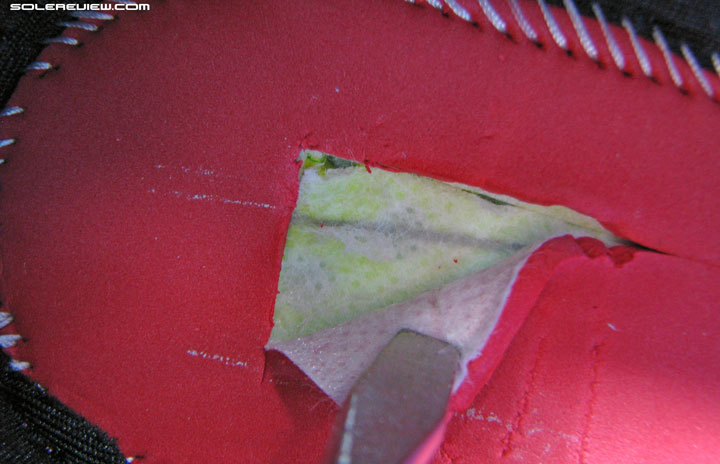
Full length and independent sheet of softer Powergrid foam works its magic in the Breakthru – in the hallowed footsteps of the Ride 7.
Let’s pore over the headlining statistics here before jumping into the deeper end. The Breakthru has a 8 mm heel to toe drop, same as the Ride 7 and a full 4 mm higher than the Kinvara.
Its midsole has a full length Powergrid foam insert (not the stamped variety found on the Triumph ISO), in contrast to the heel-only treatment on the Kinvara. Outsole is fully rubber clad, a layout very similar to the Ride 7, and definitely more durable than the lightweight K5/6.
Published heel stack heights are 26, 23, 22 mm for the Ride 7, Breakthru and Kinvara respectively, with the forefoot measuring in at 18, 15, 18 – in the same order. This is interesting; the heel thickness is closer to the Kinvara but the forefoot is more minimal than both.
And when it comes to weight, the Breakthru lies bang in the middle. For a US 11, it pushes down the scale at 268 gms/9.4 oz, which is nearly the exact average of 292/10.3 (Ride 7) and 240/8.4 (K5).
Well then? On the face of it, the data does not present a clear conclusion, because all these specs are means to an end, and not the end itself. You can sift through the clutter of empirical measurements all you like, but in the end there are only two things which really matter – how the shoe rides, and how the upper fits.
And in that context, the Breakthru is a closer match to the Ride 7, never mind the Kinvara-matching $100 price. Want that opinion in approximate numbers? We’d plug this shoe at a mix of 75% Ride 7 and 25% Kinvara, both in form and function.
Key to this line of thinking lies in how the midsole is designed, and consequently, how it functions. The Breakthru’s 8 mm drop and the full length Powergrid insert makes it the Ride 7’s blood relative in cushioning feel, and the Kinvara’s distant cousin.
The heel area might not have a separate crash pad, but the lateral midsole wall has a similar flare and compression groove like the Ride 7. Oh, and before we forget, the removable insole is also identical to the Ride 7; a soft, foam molded insert made with identical material.
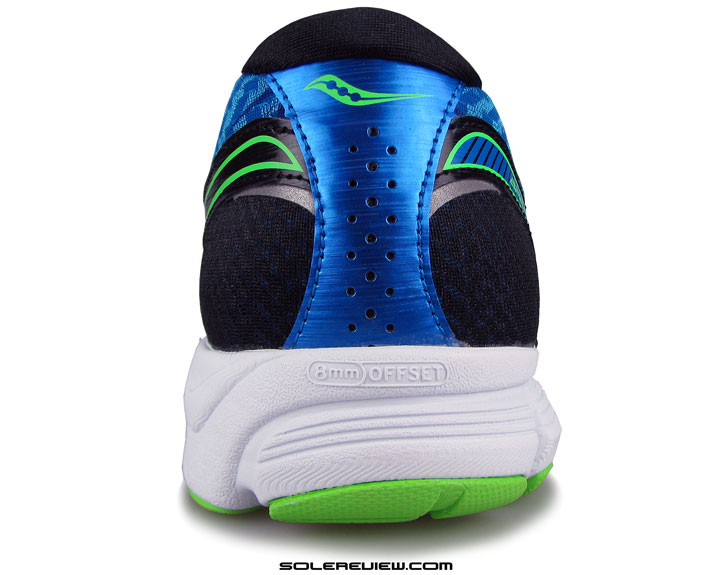
Might not have the separate SRC crash pad, but the heel works out cushioned nevertheless. Less than the Ride 7, but more than the Kinvara.
That makes the Breakthru a very well cushioned shoe in the heel, with a certain level of responsiveness delivered from the lime green hued Powergrid. The lack of the softer SRC foam crash pad on the lateral side reduces cushioning compared to the Ride 7, but it still ends up being softer than the Kinvara.
The wide groove on the outsole – the one which spans from heel edge to forefoot and helps transition – has a depth which is more or less similar to the Ride 7. It splays out on impact, and performs a contributing role in how the cushioning feels.
One trait makes the Breakthru stand out when compared to the Ride and Kinvara, and that’s the forefoot. As highlighted earlier, the nose end of Breakthru’s midsole is thinner by 3 mm (approximately 20%) than the other two, and that makes for a nicely connected experience when in motion. There’s better ground feel and feedback than the R7 and K5, and at the same time the Powergrid layer and blown rubber coverage filters out any potential bone jarring sensation.
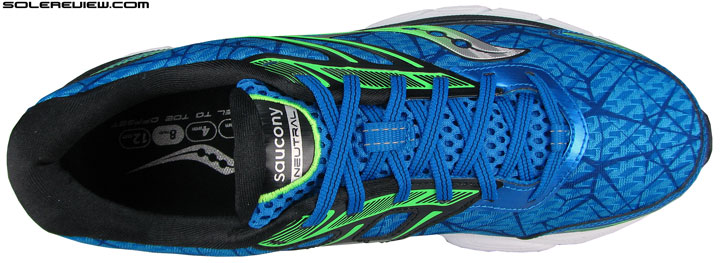
The forefoot lies lower than the Ride 7 and Kinvara, and visually splays outwards. Good for planted feel and front-end stability.
Forefoot strikes feel more efficient, as the midsole’s toned down heights in that portion helps in better touch and go. There’s a certain amount of stiffness too; flexibility is on par with the Ride 7 and lower than the Kinvara, and what worked well for the R7 does not disappoint here. There’s a assuring sense of plant. Much like the $20 more expensive Saucony Ride, the midsole flares out on either sides and creates a wider base for the foot to rest on.
The insole also sits inside the midsole instead of on top of it (unlike some shoes) , which keeps the foot cradled with a sense of cohesion. Things aren’t too shabby at the rear too when it comes to stability. The white midsole foam is firmer than the Saucony Ride and similar to the Kinvara, and this keeps sideways movement under check. There is a hint of lateral bias in the heel because of how the midsole is constructed.
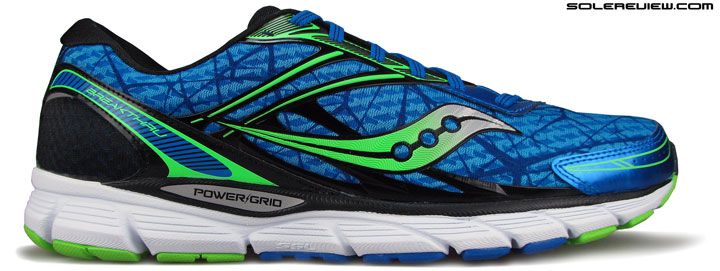
…and the lateral midsole wall is ridged, with the upper and lower parts visually separated. Hence more compression occurs on this side, when compared to medial midsole.
Medial face of the midsole has a solid sidewall, but turn the shoe laterally and you’ll see that things are different there. It mimics the Ride 7 design, with the upper and lower half of the midsole separated by a deep ridge.
This results in a greater level of compression when weight is applied, and hence the tiny amount of lateral leaning. Not an unusual behavior, since a lot of neutral shoes do that. But nothing which adversely affects stability, and most will not even notice.
Transitions come smooth and progressive here. A full length Powergrid under a cushioned insole helps produce a consistent feel, and this is also the place where the outsole design comes into its own.
The lowest part of the Breakthru has a full ground contact design with hard wearing carbon rubber in heel and midfoot, and a more pliant blown rubber under the forefoot.
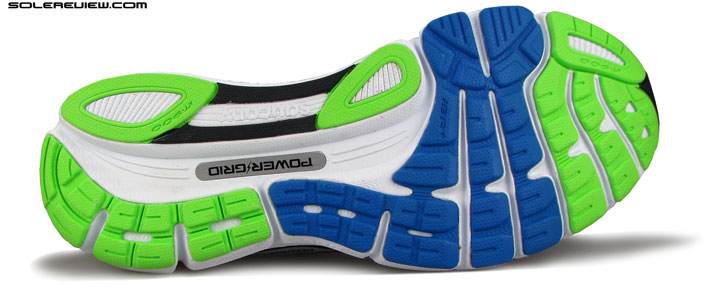
Lots of outsole rubber in full contact configuration, but sliced and diced by regular placement of flex grooves.
There is articulation in abundance, with visible (and functional) flex grooves splitting the entire outsole length at regular intervals. Weight loading in either direction comes with a level of refinement expected out of such a layout. The exposed area of midsole foam distinctly halves the outsole into lateral and medial sections, and this helps with centering weight, as it splays open when the foot goes over it.
Add to that the design fact that the forefoot rubber lugs have a slanted edge instead of squarish rubber blocks. Which when translated into real world usage, means that the underside acts as a cohesive unit instead of being felt as individual lumps of rubber. Which is another plus on the transition side of things. And speaking of rounded edges, the outsole heel has one, and eases heel-strike.
Piece all these characteristics of the Breakthru together, and what comes together is a ride experience which feels similar in many ways to the Saucony Ride 7. In this case, the most obvious reasons influence that outcome. Things like a full length Powergrid identically inlaid across both models. Or the Breakthru’s 8mm drop which will make most Ride 7 owners feel at home. And the full contact outsole beneath with identical toe springs performing at a similar level.
The just-under-the-foot cushioning experience closely resembles the Ride 7, as the insole and Powergrid combine together to form the first layer of smooth, consistent cushioning. The difference is felt deeper under the heel, where things take a turn towards the stiffer side, and the forefoot, which feels a little more road-hugging. That is much in thanks to the Breakthru’s relative forefoot thinness.
Even if you excluded the Ride 7 out of the picture, the Breakthru is capable of staking its own when it comes to cushioning and transition. It’s neither too soft nor too hard, and delivers an efficiency of cadence which many should appreciate. Good for short and longer runs alike, where you appreciate the cushioned feel yet crave for a quick touch and go. At just over 9 oz, there isn’t much weight to lug around either, so that’s another brownie point scored.
Most of the reflectivity is packed in the lower half of the Breakthru, following the Kinvara template. The Powergrid text callout on lateral midsole is printed on a reflective base, and then there’s the Saucony specific part under the outsole.
The reflective part glued in the recessed outsole makes itself useful during the gait cycle, as you kick your foot back before the next phase.
Upper reflectivity on the Breakthru is a tease, really. A couple of small strips flank the heel, and two lace-loops on the tongue have dashed reflectivity woven into them, like how it is on the Ride 7.
Still, better than how Kinvara deals with it. (note: our comment is specific to K5; the Kinvara 6 has a reflective heel).
The Breakthru uses the same SK-51 last (going by insole markings) as the Ride 7, which indicates at both shoes sharing a similar fit. But while a last is the fundamental behind upper fit, it isn’t the ‘last’ word.
Variation of materials and playing around with design components can end up making a shoe fit differently from another, even if the two happen to share the same last.
There is nothing dramatic on the Breakthru’s upper, and the design is kept very basic. No ‘pro-lock’ midfoot band of the Kinvara, and not even an upper sleeve.
From that lens, the Breakthru is much closer to how the Ride 7 fits and feels, except for a few tweaks here and there. And what differences might those be?
A couple of those differences have to do with how the forefoot feels, and then there’s how the heel is designed. First, the forefoot. The Breakthu’s toe bumper – the piece of synthetic protecting the tip of the shoe – is pulled forward, making the toe broader and freer than the Ride 7 and Kinvara. The big toe feels less of the upper material pressing on it, so in a way the toe box height is higher than the other two. But there’s a trade-off for the extra toe box height, which brings us to the second design change.
That has to do with lacing area. What about it? Well, the lacing starts much earlier in the forefoot than Ride and Kinvara. (see our infographic) When measured from the tip of the shoe, the length of the open area is 5 mm shorter than Ride 7 and a substantial 10 mm relative to the Kinvara 5. You know what follows next. It makes the forefoot height feel shallower, and the early lacing tugs on the side, leading to a narrower fit.
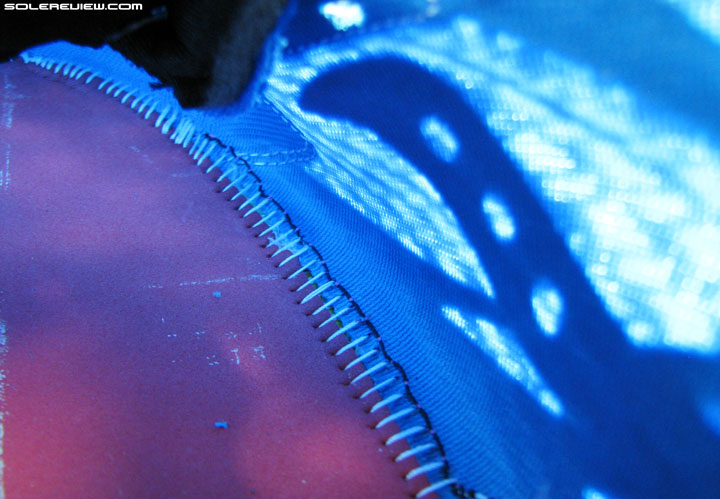
The forefoot might have overlays, but fits narrower than the Ride 7 and Kinvara due to lacing start early.
The sideways room on the Breakthru is a step down from the Ride 7, while being noticeably narrower than the spacious Kinvara. There are no width options on Saucony’s website, meaning that if the shoe doesn’t fit, you would need to either buy the R7 or K5.
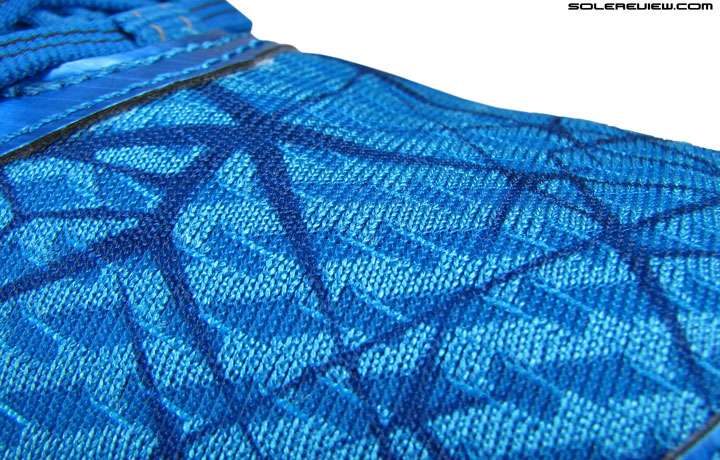
Closed mesh of the Breakthru – less ventilated and elastic compared to K-5 and R-7. Looks beautiful, though.
Looking at the pictures, one would have thought the Breakthru to have more room than the Ride 7. The mesh is overlay-free in the forefoot, unlike the Ride 7 where welded TPU ‘fingers’ ran amok over the surface. But after wearing the Breakthru, the pieces come together and makes sense of why the shoe fits narrow.
The early lacing results in a larger expanse of the forefoot being influenced by cinch pressure, and the closed mesh does not have the slight stretch of the Ride 7 or Kinvara 5’s open mesh. A minor side effect of this is also reduced ventilation; less air tends to pass through the Breakthru’s guarded surface than the open pores of the Ride or Kinvara’s spacer fabric.
This narrowness of upper – both across early forefoot and sides – will be a turn off for runners accustomed to the relative ease of Ride 7’s or K5’s upper.
Heel collar materials borrows from the Kinvara, using a smooth RunDry lining material. Where it differs though, is how the counter is molded. Inside, there is a full size stiffener, leading to structural similarity with the Ride 7 (Kinvara had a toned down, half counter inside). Grip does ok, but this aspect is bested by the Ride 7’s plusher heel, which tends to close in around the ankle more aggressively.
That said, it should not be an issue for sensitive Achilles. Only 3/4th of the heel height is rigid, and the remaining 1/4th margin is topped off with soft collar mesh.
Midfoot panels and construction visually resembles the Ride 7, and that converts into functional likeness. Welded support and molded Saucony logo on the lateral side is borrowed scenery from the Ride 7, and so is the medial synthetic panel.
Tongue is traditionally built – euphemism for no gusset – so expect a minor amount of slide. Its foam padding absorbs pressure from semi-stretch laces, and the midfoot fit feels consistent, as there are no design features like the Prolock (Kinvara) which makes one area tighter over the other.
There is a small issue with the tongue lining, a feedback you’ll only get when wearing the Breakthru barefoot. The insides edges tend to curl over the bareskin, and though they seem incapable of creating blisters, the material is felt over the foot. Despite the Ride 7 and Breakthru sharing a similar tongue design and dimension, the quilt stitch line on the Breakthru is a few millimeters afar from the edge, which causes the excess material to curl over.
This wasn’t a problem on the Ride 7 as the stitching was extremely close to the edge. But like we said, this is only a without-socks usage problem, so we won’t hold it against the Breakthru. Apart from this, there really isn’t anything to nitpick anyway. Ok, if you insist, the narrow upper isn’t a one-size-fits-all kind of deal, given that there are no options to buy additional widths.
The idea of mating a Ride 7 and Kinvara was a sound one, and putting that into practice does not disappoint. The Breakthru is a proof of that concept, and ends up striking a fine balance between delivering excellent ground feel and a cushioned ride, a feat which many shoes attempt but seldom achieve. It is also very sensibly priced at $100, packing in the goodness of two great shoes for the price of one.
(Disclaimer: For this review, Solereview bought the shoe at full US retail price.)

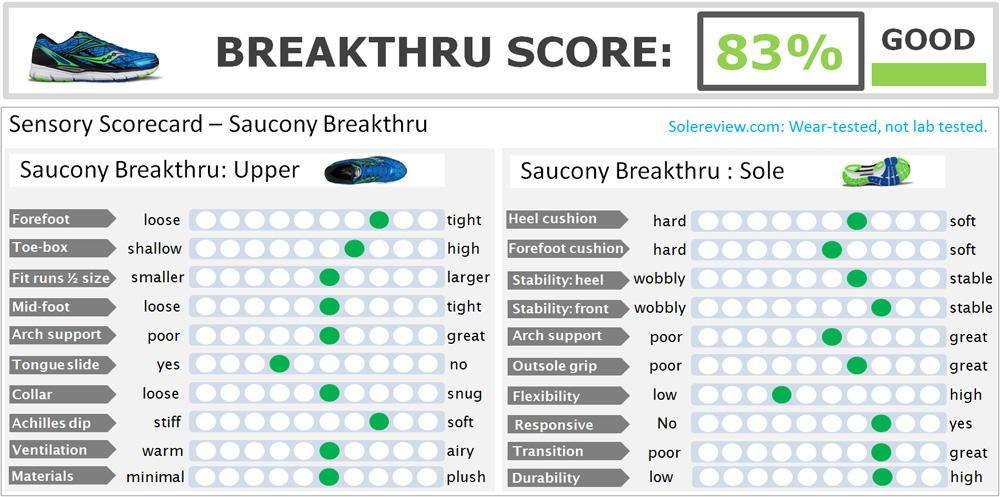
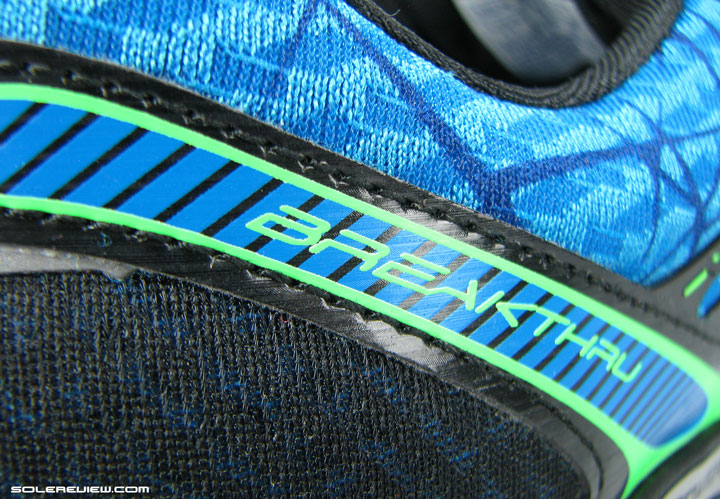
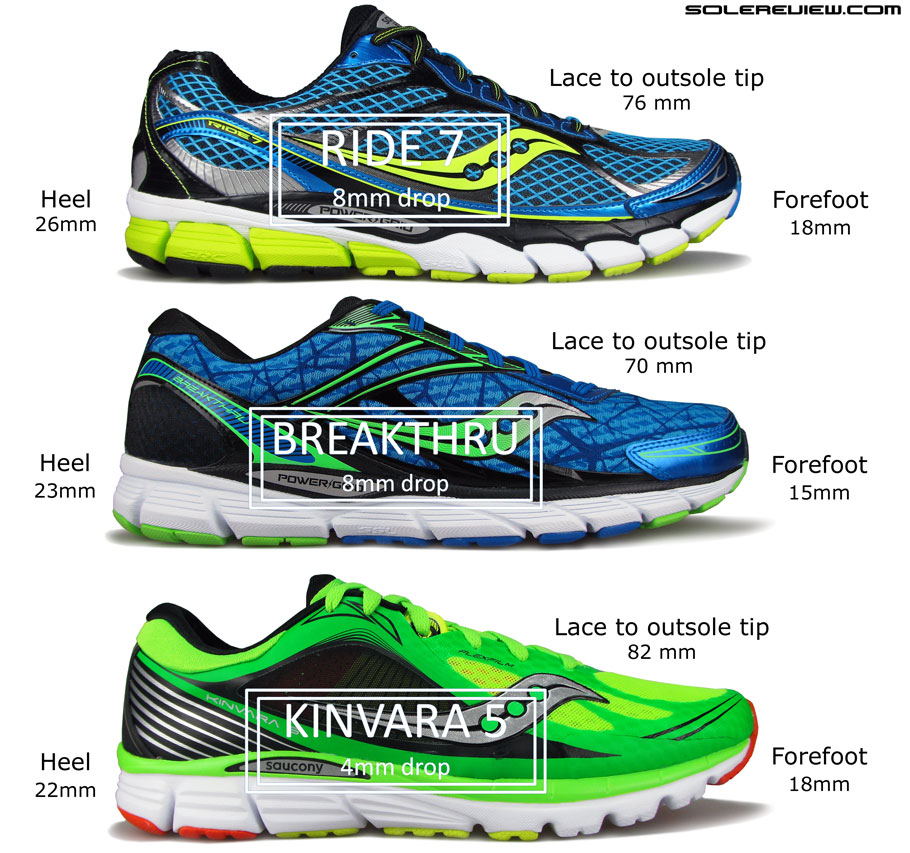
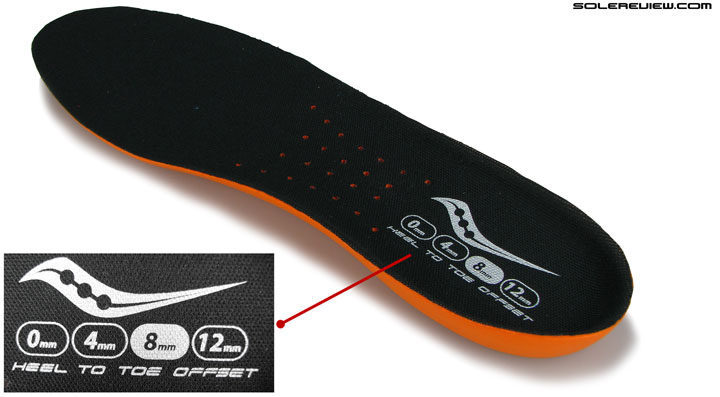
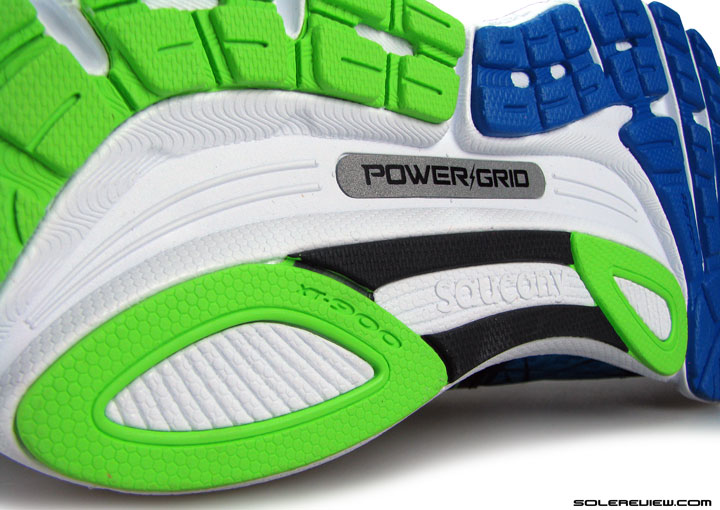
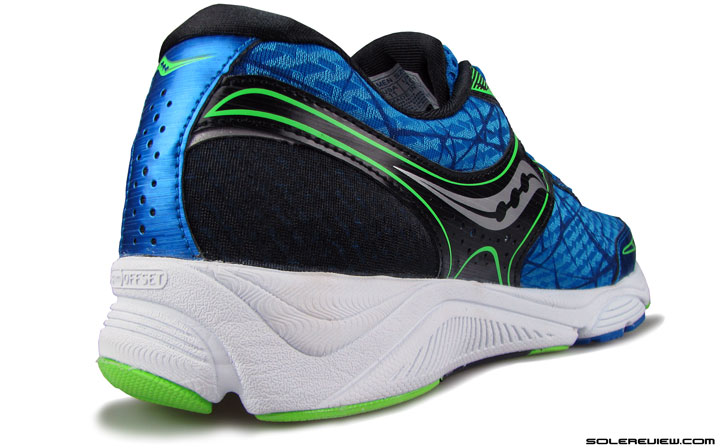
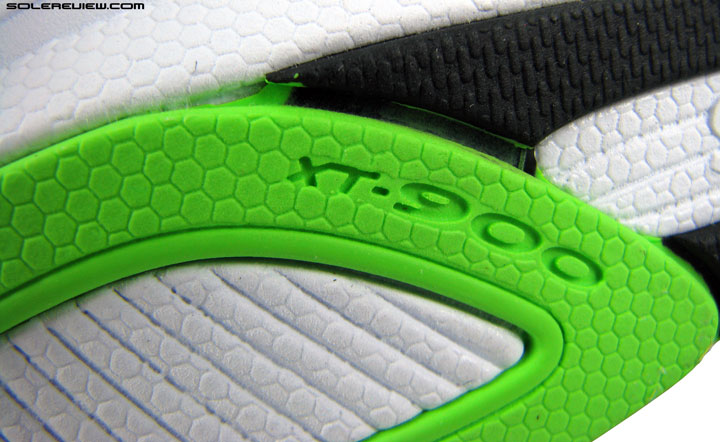
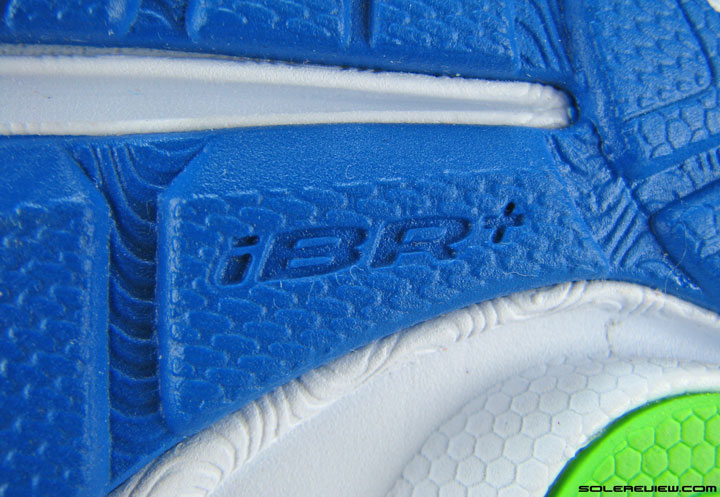
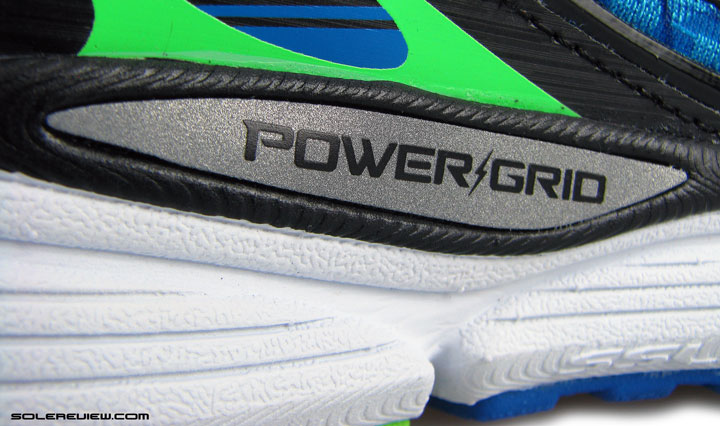
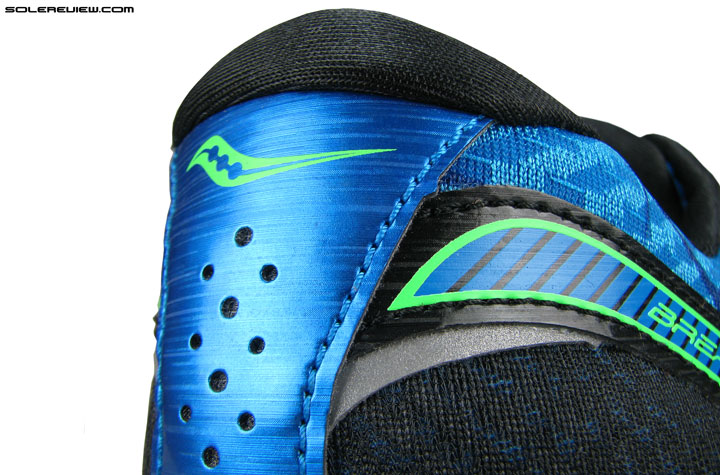
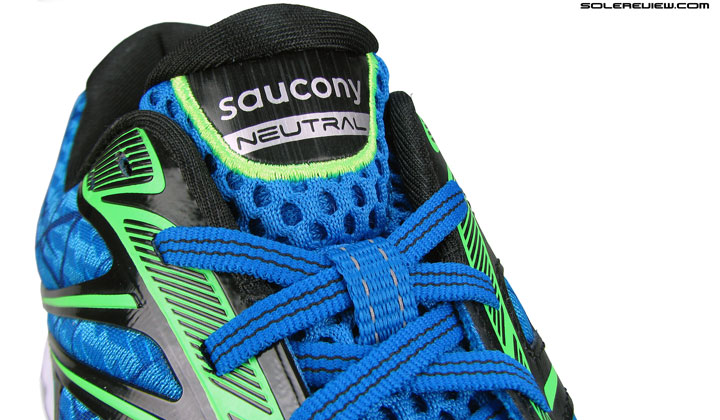
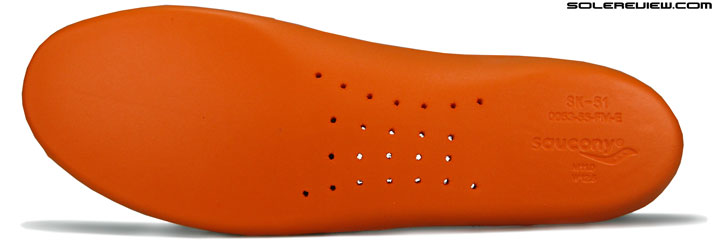
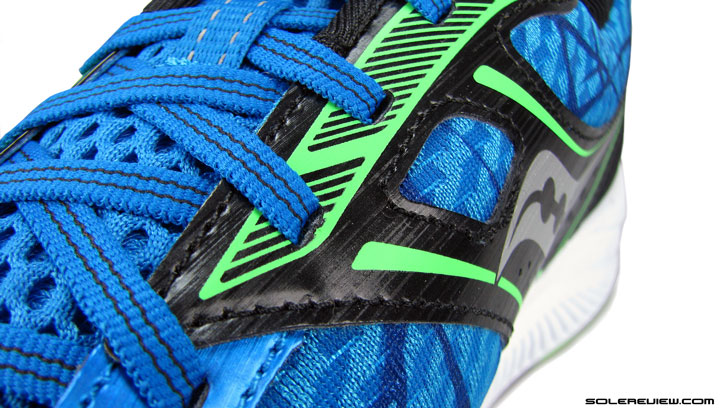
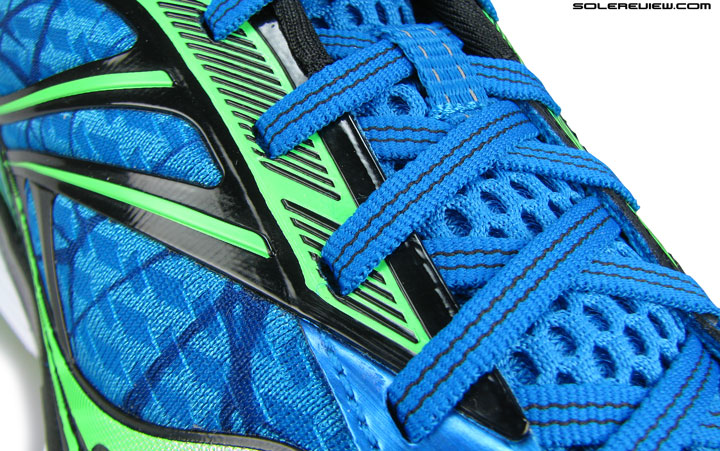
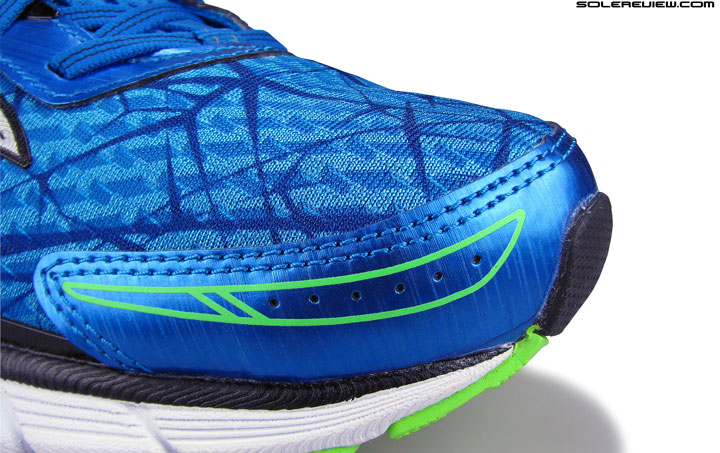
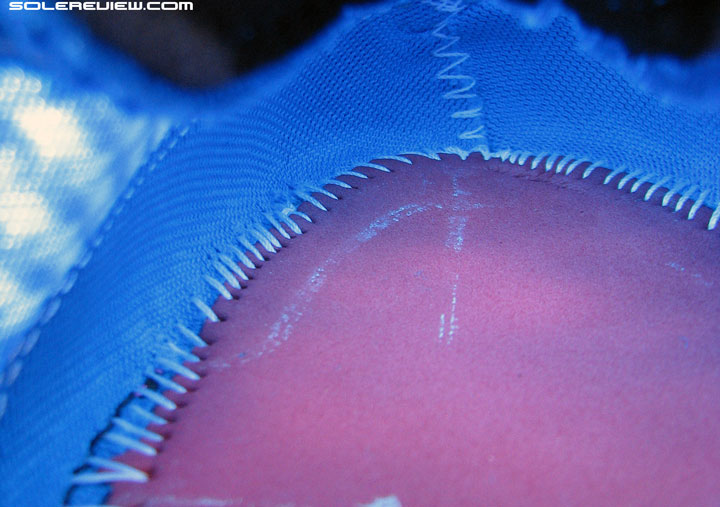
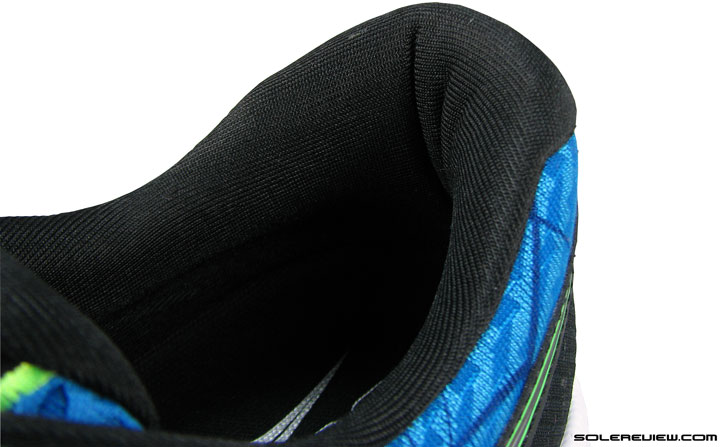
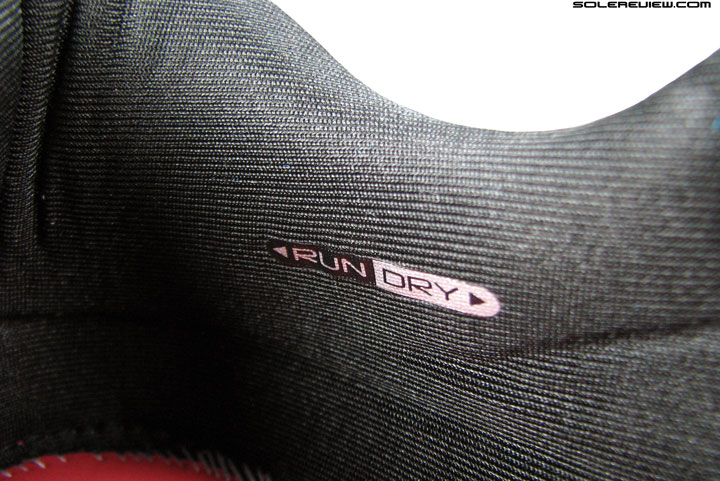
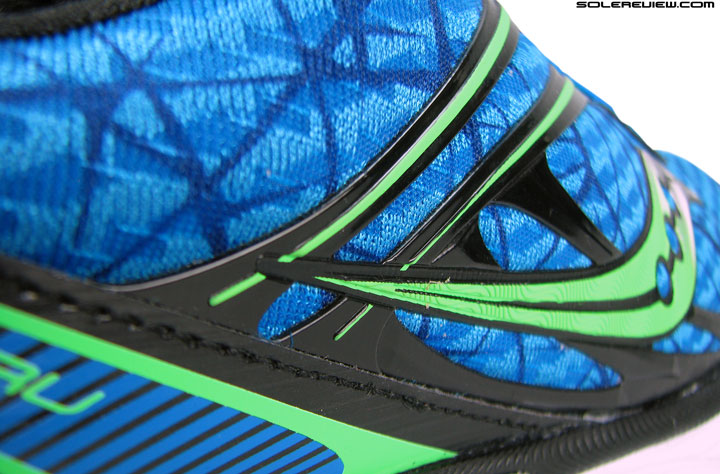
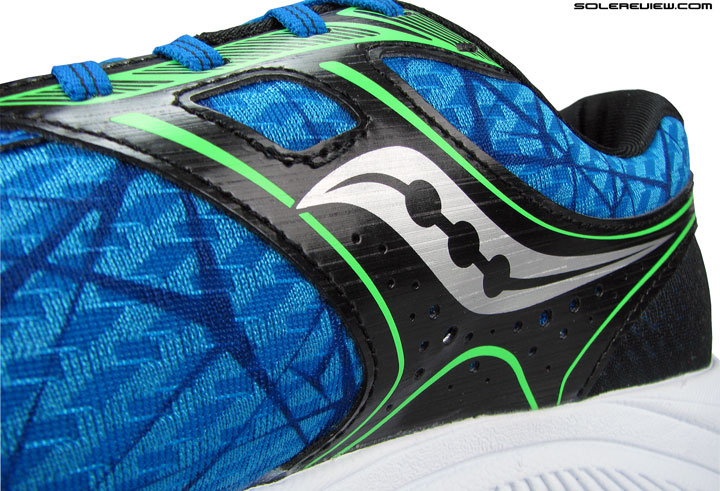
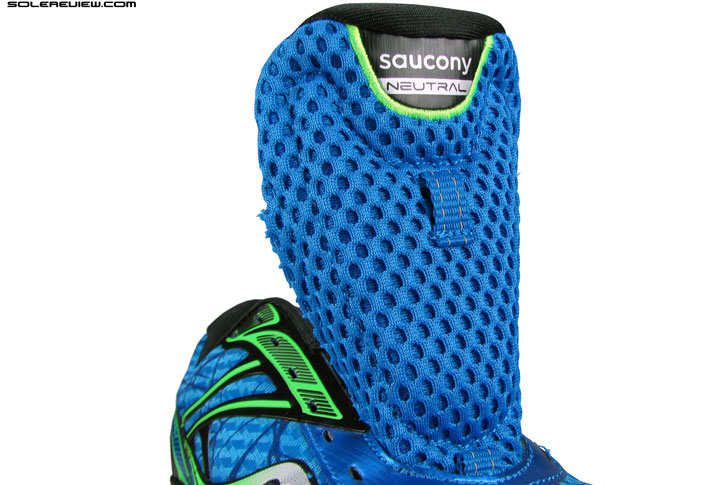
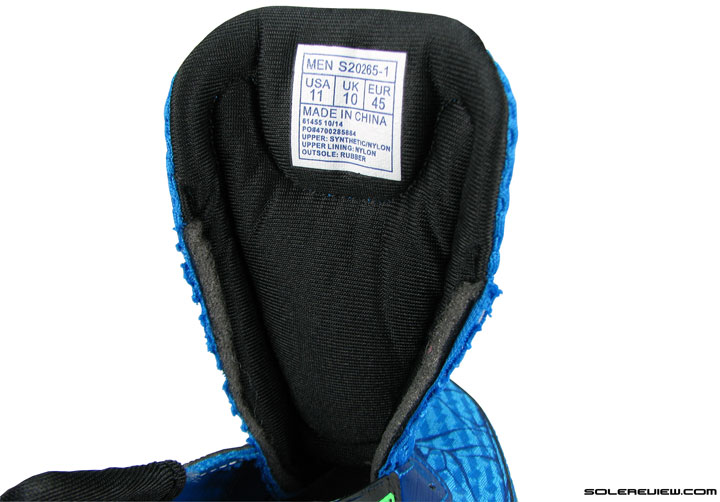
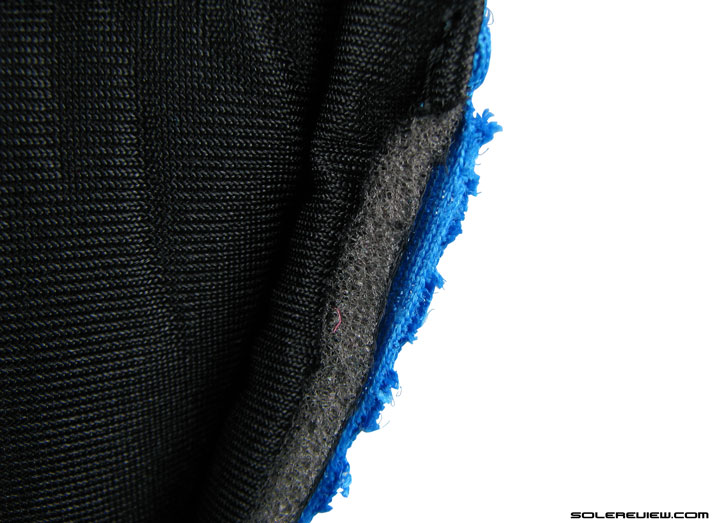
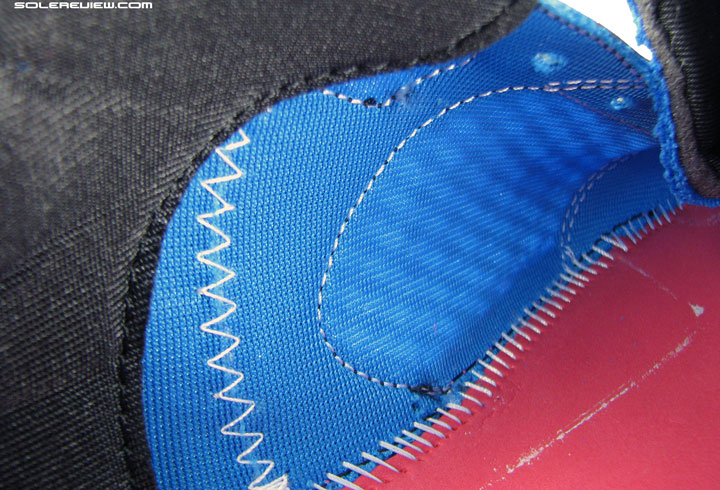
26 comments
Great review! Appreciate your reviews very much. Always enjoy reading them. I always look forward to the new ones. May have to give the Breakthrough a try. Thanks.
Thank you, Mark!
i know you are shying away from the calendar–any chance you could let us know what is on the horizon? Specifically interested in the flyknit lunar 3. also, do you guys ever plan on reviewing the flyknit racer? older shoe, but popular. thanks.
Sure, here goes in no particular order: Mizuno Hitogami 2, Hoka Vanquish/Constant/Bondi 4, Nike Flyknit Lunar 3/Free 4.0/Free 5.0/Free 3.0, Lunar Tempo, Lunaracer 3, Vomero 10 New Balance 890 V5, Brooks Ghost 8, Glycerin 13, Asics GT 1000 4, Saucony Ride 8.
No plans for the Racer, at least in the next two months.
We know that you don’t do the calendar anymore because the impatient people ruined it for us but why don’t you list all the upcoming reviews and not attach any dates to them?
That will open a new can of worms because people will start asking the dates for each one, then.
I wonder if you plan to review any Newton shoes ? They arent distributed in my town here in France and i have to buy them online, but given the quality of your review i would be interested ;p ( Fate or aha would be awesome ). And a question related to Breaktru, how would you compare them with asics Ds-trainer/noosa ?
No Newtons for now, they cost a lot and global distribution is very limited. Don’t know how the Breakthru compares to the DST and Noosa, haven’t reviewed those shoes.
Brooks Launch 2 still in the pipeline? Thx. fab reviews. One suggestion, could you include the weight/height of the reviewer(s). Some shoes seem to work better for lighter, some for heavier runners.. Cheers.
Yes, the Launch 2 will be reviewed, but not sure when.
I was becoming more and more enthused while reading your review until I got to the part about the narrower forefoot…ARRRRRRRRRGH! Why, Saucony, why???
Another fantastic review- you guys just keep getting better and better!
Thank you for the kind words!
First of all, thank you for your great reviews. In second a second time, I must tell you, I don’t speak english (I understand it when I read it, but it’s difficult for me to write it).
I hope you will understand my question. I’m looking for a lighweight trainer to prepare a marathon in 3H30 mn (my profil is neutral midfoot striker with narrow feet / 6’4″ tall / 170 lb).
In theory, the Saucony Breakthru and the Adidas Boston Boost meet my expectations. But It’s impossible for me to try these shoes at my local shop, so I must orderer them online.
Wich one have your preference? Do you have other suggestions that could meet my needs?
Thank you in advance for your answer.
We’d side with the Boston 5 Boost, but many other reviewers have pointed out the lack of upper durability within 100 miles or so. Other than that, the Boston is responsive and good for forefoot strikers.
Also consider the Nike LunarTempo and the New Balance Fresh Foam Zante. We do hope your online retailer allows returns – sizing can be an issue across brands/models.
Great review as always!
Could you reccommend any good shoes that I can use as an everyday trainer? I am a forefoot-striker and I currently run in the pegasus 31 which I love. I love the amount of cushioning and the upper feels great. I run on average 5K’s per run.
I’m looking for a neutral running shoe, but there aren’t many options at my local shop so I want to know what size I would be if I have to buy the shoe online. I was a size 10 in the peg 31’s. Preferrably one of the major brands (adidas, nike) but if you think a shoe is really good I’ll try it out.
Thanks in advance.
Try the Nike Vomero 10 or the adidas Supernova Glide 7 Boost (on this, you might have to go a half size up). Trust that the online retailer has an exchange policy if the sizing doesn’t work out.
Would the glide 6 boost work the same as the 7? I’m only asking this because the 7 has bad aesthetics.
So the ultra boost won’t be good for me?
The Glide 6 will work perfectly fine. The Ultra Boost is good, but outsole durability and grip on wet is terrible.
Thanks I just run on dry wet roads so I’ll use the cheapest of those ones.
So sorry- I just do it on the most recent post :(.
No problem, staying on topic just makes comments relevant for the rest of the readers, that’s all!
Hey ya’ll. Again, great work. I’m running in the Ride 7s now and have been looking for something that falls between those and the Kinvaras (the prolock on the Kinvaras killed me and the 4mm drop was too aggressive) in terms of weight and responsiveness. The Breakthrus were sounding like exactly what I was looking for until we got to how narrow they are. Any suggestions on a shoe that fits a similar bill as the Breakthru that isn’t so narrow? Thanks!!!!
The Nike Lunar Tempo is something you can look at. Of course, a very different shoe, but the upper is relatively easygoing and the midsole feels snappy yet cushioned. The responsiveness level is between the Ride 7 and Kinvara, while it kills both on weight.
I currently have the Adidas Energy Boost 2.0 ESM that have the breathable, sock-like upper and I hate how quickly my feet get wet even just running on wet pavement. Never had the problem with my Brooks Ghosts which I know are made of a different material, it’s just worth noting because now I am very hesitant to go with an upper that’s described as a “lightweight mesh.” How does the upper of the Breakthru compare to something like the Energy Boost or the Nike Zoom Pegasus which seem to have similar uppers.
We haven’t had a chance to test most of these shoes in the rain/damp roads, so won’t be able to help with your question! Sorry about that.
The comments/Q&A thread will be closed till January 17, 2016. Premium access members can continue to use their dedicated comment section, which will be open.
Comments are closed.